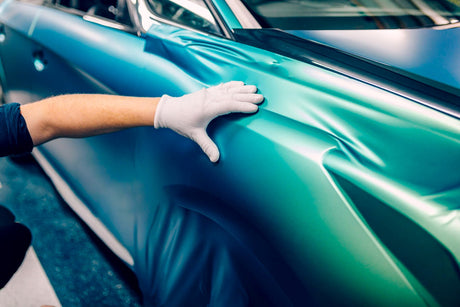There are times when the material gets bunched up on a difficult section. But with a combination of techniques and a keen reading of wrinkles can be used to keep the quality and durability of the install intact.
Let's take a roof wrapping as a study case. So to do this, you have prepared everything right. You pre-cut the sections, secure the panel with magnets, cut the backing paper away, and fold it on itself to make it easier to pick back up later.
Then you start your install, you form the film around the antenna first, because this part is always important. And you start with the front of the roof, secure the panel with a permanent hinge, then you work towards the antenna. These are all the right things to do. But then you see the material starts getting bunched up.
As you pull the material back up, you will see there are lots of accessed films on the backside of the permanent hinge, which makes it very difficult to apply because now it bunches and wrinkles occur.
These are common problems when you come across roof wrapping because there is a slight concave curve up there.
At this point, instead of picking up the entire panel and starting to get it from scratches, there is a way you can manage the film without slamming it with heat and overstretching it. What you need is a combination of application glove, heat squeegee strokes.
The trick is to use the recessed area to handle your film, by bridging on the top section between the recessed area. And instead of working into the recessed area, you can use your thumb to bridge on the other side. You might then figure all the wrinkles are in that above the recessed area there.
Based on reading the wrinkles and the shape, the wrinkles might not be sharp. So the right way to do is to squeegee in the middle, bridging the gap between the two. Wrinkles might still be there, and they are not steep enough. So they are going to fold on themselves.
Now give your material a little heat to relax, and then squeegee on the deep side of the recessed area. Notice though, if you go with the flat section first, there might be too much tension on the corner.
Heat it and form it evenly. Your film will go back flat and properly. But to achieve this result, it is good to do different techniques and different styles based on the wrinkles. Do not forget: It is a wrapper’s job to constantly read the material and make the adjustment.








